Christine Macrae: The West End Good Book Guide
The book guide is no longer updated
Book Guide 13
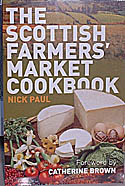
The Scottish Farmers? Market Cookbook, Nick Paul, Angels? Share.
We?re lucky in Partick with the market on our doorstep but this book heightens understanding of the wider farmers? market movement and what it represents. My Elizabeth Craig Scottish Cookery Book dates from the fifties, so was good to be brought a bit more up to date, or we?d be living on porridge and Dundee Cake. Entire meals can be planned from the distinctly Scottish recipes here and made with home sourced ingredients. Try cullen skink, venison casserole and raspberry yoghurt pie, or cheese souffl?, scallops in black pasta with chilli and lemon curd ice cream. You don?t need to be an adventurous cook. These recipes are contributed by producers who know as much trout, boar cheese or whatever as it is possible to know, so you can?t go far wrong. However what I like most about this is the directory of producers which gives details on which markets they attend and other ways their stuff can be procured. There is also a guide to what?s in season, farmers? market times and locations as well as weights and measures.
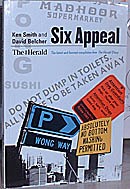
Six Appeal, Ken Smith and David Belcher, Mainstream.
?If you?ve so far been unaware of The Diary, buying this handy distillation of its past two years of publication will increase your virility, stave off dengue fever, combat emotional turmoil and charm cats down from trees- possibly.? For once the back page notes really do say all that can be said. Wit is a tradition Scots kids are brought up in; you don?t need to spend long in Glasgow to understand how effective the training is, with smart retorts commonplace and passers by cracking jokes crossing the street, a not infrequent occurrence on Dumbarton Rd. Smith & Belcher are great collectors, one wonders if a single Glaswegian cab driver or Edinburgh shopkeeper is beyond their earshot. As soon as has some hapless buffoon has the piss taken out of him, they get to hear about it. When they run competitions, readers deliver. There are great updated proverbs, (if you can?t stand the heat you?re probably not going to like Hello! either) advertising slogans (welcome to Scotland, sorry about the mess) 60s hits revisited for aging baby boomers (rakin up is hard to do) and killer lines for famous films. There are 28 sections to this book so choosing a favourite is impossible, though I like ?Scotland?s money pit? and the chapter on the G12 postcode that made me grateful I?m in G11, where babies suck bottles of Iron Brew and the plain loaf has yet to give way to the ciabatta.

Scottish Architecture, Miles Glendinning and Aonghus MacKechnie, Thames and Hudson.
A concise history of Scots architecture, what more could one want? In six chapters , Prehistoric and early historic, from Christendom to Kingdom, The age of revolutions, the age of improvement, the high summer and 20th century, building the social nation, Glendinning and Mackechnie tell the story of our built environment and shed light on why American tourists gasp ?It?s so historic?. The oldest stone built houses in Europe are in Orkney at Knap of Hower, while Skara Brae is the best preserved settlement. We can see, 5000 years later, how populations not only survived but thrived. This is a story of people and landscape, fortresses on outcrops, castles and monasteries, with influences from abroad made visible in stone.
Among many lovely photos the two of Glasgow Cathedral, ?the most important and unified monument of the relatively short period of Gothic ascendancy in Scotland? stand out. It?s the early stuff I love, but Scots builders have never rested on their shovels. In the years between the 16th the 19th centuries saw the addition of great houses and public buildings, , which we risk taking for granted. Many remain well preserved but much is lost, with photos and records all that remain. The Scots have always been keen on new influences, as some great 20th century stuff here makes clear.
? if ever there was a golden age of Scottish architecture, it was the Victorian era of imperialism and British global might. The challenge now is whether that achievement can be matched again by future generations of Scots without the supporting infrastructure of empire and world economic dominance.?
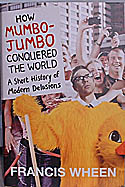
How Mumbo Jumbo Conquered the World, Francis Wheen, Fourth Estate, London.
We should be on our knees with gratitude for this polemic on the retreat of reason in the late 20th century. Wheen begins by connecting two events of 1979 that shaped the next twenty-five years, the arrival of Margaret Thatcher and her ambition to reassert 'Victorian values' and the return of the fundamentalist cleric Ayatollah Khomeini, setting out to restore a regime that had last existed almost 1,300 years ago In Iran. Between them, he asserts, they succeeded in bringing the twentieth century to a premature close as tracks of dogmatic monetarism and dogmatic fundamentalism converged bloodily 22 years later. There is more than enough material to make the point but not much on reasons why. Hugo Young?s Thatcher book made clear what a hand to mouth business her government was in reality. Wheen doesn?t outline curatives, other than calling for a defence of the values of the Enlightenment in the face of a tide of ignorance which would make a stoic weep. Once in his stride, cults, quackery, gurus, irrational panics, moral confusion and an epidemic of mumbo-jumbo are all demolished, not even the Dalai Lama is exempt. This is the story of modernity challenged by a pre-modernists, post-modernists, medieval theocrats, New Age mystics and personalities of the post-political era -- including Princess Diana and Deepak Chopra, Osama Bin-Laden and Nancy Reagan's astrologer. With the rise in superstition, relativism and emotional hysteria over the past quarter of a century, things stopped making sense. To read of Tony and Cherie Blair's rebirthing experience in a Mexican mud bath in 2001 is to be torn between hilarity and despair and Wheen demonstrates the nakedness of numerous emperors. The quotes on front and back may lead you to think this is a work of comedy, but it's deadly serious, not all fun and games.
Jan 05
Oct 05
I and have neglected this too long and am contrite . There are no excuses, but thank you all for the comments. I'm on the case now. Christine
Book Page 10 August 03
Apologies for the extended interval since page 9. Though no excuse is required, I have to say my attention was focused elsewhere. There were a series of domestic crises involving a close relative and Shane McGowan. There was Sean winding up on morphine in Yorkhill A&E, having swung from a doorframe with such seven year old exuberance, he fell and broke his arm in two places. There was a holiday in Devon finishing with a train journey so fraught that Virgin Rail saw fit to send a £16 rail voucher in compensation. Had it been a book token I could have bought the fascinating book I saw at the Whistler exhibition, on how the portrait of his mother became a genuinely iconic image. Whistler's Mother, An American Icon, by Margaret F Macdonald looked tempting but I managed to resist. And since the Scottish Book Publishers Association changed their review copy system, my supply of up to date material has dried up. Since May I have been sent "Shriek of the Maws" and "Churches and Abbeys of Scotland" and sweet fanny adams else! Both are from Golbinshead of Musselburgh who publish "popular and tourist books on Scottish history, castles, biographies, architecture; prehistory; travel guides; other Scottish interest; ghosts and hauntings; scottish fiction" They have a terrific list, but it is no disrespect to the two worthy volumes below to say I am a tad disappointed.
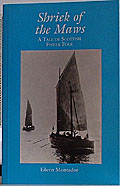 Shriek of the Maws. Eileen Montador. Goblinshead.
Shriek of the Maws. Eileen Montador. Goblinshead.
This book deserves a decent audience, not only because of the authentic east coast dialect, but also because it's dramatic and would make a good script for a radio or stage play. Drama students hunting a meaty Scots audition piece could do worse. It's clear that Eileen Montador, a native of the fishing village of St Monans in Fife where she still lives, has a fine ear for language and is able to put it onto the page with no loss in transmission, a rare talent indeed. Writers take pride in their own idiosyncratic ways of getting spoken Scots down and often the onerous struggle to read what's written is offputting to all but the most dogged and enthusiastic. But this is an accessible, atmospheric and engaging tale of the lives, work and loves of Scottish fisher folk, told by one fishwife from her fireside as a storm brews out to sea. The narrator really lives as a character, it's not hard to visualise her and understand her need to tell her story. "Aye, an then Ah'll hear the shriek o" the maws, seagulls in the English, they've got the soond o' the cauld waves in their throats." You can hear the selfsame shriek in Partick, where it's more redolent of the landfill sight and litter strewn city streets. The folk who cast left over curries and entire loaves over our parks ostensibly to pigeons aren't helping.
 Churches and Abbeys of Scotland. Martin Coventry and Joyce Miller. Goblinshead.
Churches and Abbeys of Scotland. Martin Coventry and Joyce Miller. Goblinshead.
The first in a new series, Thistle Guides, which will cover Scotland's buildings, history, heritage and architecture, this is a neat handbook on the churches, abbeys, cathedrals, chapels and carved crosses found all over Scotland. Buildings so much part of the landscape that I for one am guilty of paying insufficient attention and taking our precious and unique heritage for granted. From my own flat I can see four different churches, including Govan Old Parish Church across the river, mentioned here and well worth a visit for the fine collection of early Christian stones and immaculately maintained graveyard. A five minute walk takes me past several more. Glasgow Cathedral, St Marys Cathedral and Queen's Cross Church are included of course as is the Cathedral of the Isles in Millport, Britain's smallest cathedral, dating from 1852 and designed by Butterfield. As well as a helpful map, comprehensive notes on saints and monastic orders, and a glossary of architectural terms, there is a concise overview of the story of religion and worship in Scotland, from the Roman invasion, St Ninian, Celtic Christianity, the Reformation to the Covenanters and Disruption. A great wee book.
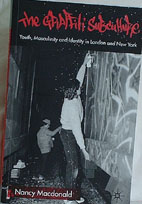 The Graffiti Subculture, Nancy Macdonald. Palgrave.
The Graffiti Subculture, Nancy Macdonald. Palgrave.
If you heard Banksy on Radio 4 this summer or read reviews of his show at the Serpentine, you'll have an idea how influential a few graffiti artists are, in spite of, perhaps because of, the horror they have of mainstream celebrity. The graffiti which brings city scenery to life is enigmatic, significant for those in the know and questions our accepted concept of art. Subtitled youth masculinity and identity in London and New York this book tell the stories behind the illegible writing and mysterious signs which appal so many and add to the council tax. Nancy Macdonald's painstaking research delved into the subculture and motives driving it. Her humorous description of her fieldwork, and the unusual perspective as a woman observing men, make this a fascinating read for anyone interested in youth, art and human nature. In a predominantly young male pursuit, girls have a terrible time gaining acceptance but a few equal the risks taken by the boys and gain credibility. It is an amusing story of criminal behaviour and heroic escapes. Though illegality is undoubtedly part of the attraction, it is the fundamental process of making your mark, which is fascinating. Identities are built on graffiti. A tag is a writer's name, a dub the outline of the name filled with gold or silver, a black or white interior would make it a throw up. A piece, short for masterpiece is a name or image painted with more than two colours. To bomb is to cover something with graffiti and up denotes prolificness. Those of us who, constrained by age and wisdom, have outgrown the primal urge to daub walls have to hand it to these metropolitan artists. Having noted the Partick Blockbusters wall scrawled yet again in dreary white names with all the artistry of a blocked drain I repeat my plea to Glasgow vandals. There are some fascinating stencils dotted around but please raise your game. The walls of London and New York find their way into books!
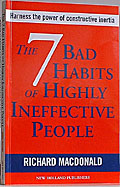 The 7 Bad Habits of Highly Ineffective People, Richard Macdonald, New Holland.
The 7 Bad Habits of Highly Ineffective People, Richard Macdonald, New Holland.
The best read I've come across this summer. I like everything about it, particularly the ludicrous diagrams which are no more absurd than many that figure in books of serious intent. Macdonald explains with striking lucidity how by cultivating 7 simple habits, we can become truly ineffective and make an even bigger shambles of our lives than the one we've made already. When you've grasped the wisdom of chapter one, and thrown your diary away, you're ready to move on to always speaking the truth. Examples demonstrate the benefits of total honesty not only for yourself but for those around you. This contradicts the never say "no" rule of course, but as Macdonald's philosophy is based on living for yesterday and ignoring the future, it all makes perfect sense. I found the chapter on retrospective budgeting the least helpful, while the one on being yourself will make life simpler and a lot less stressful for those who are open to the wisdom. By adopting 7 simple habits we can be at the airport when our ship comes in. The final chapter on habit 7, follow your heart, is the piece de resistance. We are intuitive, instinctive creatures of the universe who need not concern ourselves with facts. "By living in cloud-cuckoo land, you can liberate yourself from having to deal in reality, facts, or having to earn a living". This is done by opening up the strings of the heart chakra, a dramatic oriental technique that will show friends, relatives and enemies alike how loving, forgiving, and patronising you have become. It takes practice though, and is not for the faint hearted. "(patronising) is important because we often think it means being condescending to others but it doesn't: it actually means acting like a patron, a wealthy benefactor. And that is exactly what you have become. You now have a wealth of heart love and can bestow these riches on others". Heartily recommended for anyone who wants to learn the secrets of life's underachievers and harness the power of constructive inertia.
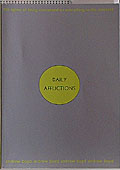 Daily Afflictions, Andrew Boyd, W.W. Norton.
Daily Afflictions, Andrew Boyd, W.W. Norton.
Forget the inner artist, this is a volume of readings aimed at those who seek to be at one with the inner corpse. It is a thought for the day type book, handicapped by its own brevity. The prose pieces and aphorisms are so intense and highly distilled that some watering down would help. Some if not all the afflictions deserve a more thorough explanation. While Boyd traces his influences through Neitzsche, Kafka, Kierkegaard and numerous others, one is left with an urge to be better read accompanied by a total absence of motivation to take it further. i.e. one has grasped enough of the rudiments of nihilism to understand the pointlessness of such activity. Though found on the humour shelf not far from 7 bad habits, this is a darker treatment of a darker theme. There are some great ideas in Daily Afflictions; the piece on "living a worthless life" is genuinely uplifting, paradoxical though that may sound. You need to be in a robust frame of mind to consider such ideas; people in the depths of despair are not known for their appreciation of humour. Much of this book though not all, is based on paradox, an exception being the simple notion that "Seeing yourself as a story helps you reconcile your forward motion and your backward gaze." Not an original idea but always useful. There are precious few books wherein sceptics who have a crisis of doubt can find succour, but this is one. And I warm to the dismal but not unworthy premise that a plausible explanation wrought from hindsight and flawed is preferable to no meaning at all.
 Chapman 102-103 Centenary Issue, part 2 (of three)
Chapman 102-103 Centenary Issue, part 2 (of three)
This is so crammed with the great and good of Scottish letters, one hesitates to comment or presume to pass judgement. There are many weel kent faces and much of this is sheer pleasure. On reading Clothes by Liz Lochhead, her voice is so distinct it is almost uncanny. The same is so of Anne Donovan, Bill Duncan and many more. I do love an illustrated volume, and was thrilled with the selection of John Bellany paintings, mostly self-portraits, monochrome and full colour, preceded by a witty introduction from Joy Hendry herself where she details his problems with the printed word. People who have been around and paid attention will be familiar with many names here which are to new to folk like me who went away and applied themselves elsewhere. This volume celebrates William Neill, 80 last year, "one of the most underrated wordsmiths of the 20th century" a "makar in thrie leids". Then there is Ian Abbot, the noted poet, of whom I am ashamed to say I knew nothing till this book landed on the mat. There are interesting reprints of earlier seminal articles for Chapman, like Joyce Macmillan's piece from Chapman 35, and Donald Smith puts a reasoned case for a "Literature Council for Scotland" in his essay on Scottish Literature after the First Parliament. It's an awful lot to take in, all of this.
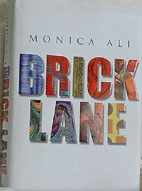 Brick Lane, Monica Ali, Doubleday.
Brick Lane, Monica Ali, Doubleday.
The only novel here, and the only 2003 Booker contender I have read so far, Brick Lane deserves every plaudit heaped upon it. It's an amazing book, a literary novel of impeccable style. While telling a simple story Ali paints a jewelled picture of the lives of Bangladeshis in London. Her characterisation makes this book a classic. Nazneen's is sent from Bangladesh to Britain at the age of 18 to be married to Chanu, knowing only two words of English - sorry and thank you - and not a soul. As an infant left to die she survived and despite the forces against her, the limitations of Chanu, her lack of language and education she continues not merely to survive but develop her own identity and determine her own fate. Nazneen is surrounded by wonderful characters, none more bizarre than the ghastly Mrs Islam who, accompanied by her sons, drifts in and out in a menacing mist of Ralgex Heat Spray. Razia, her friend has problems with her own family, but the tension between traditional Islamic and twenty-first century urban culture affects everyone. Echoes of home persist, people are defined by being Bangladeshi years after they have left. Karim, who disrupts Nazneen's life when she should be a settled woman, has never even been there. The pulls and pushes of home are dramatised by Hasina, Nazneen's sister, who took her fate into her own hands and made a love match, only to see her life spiral out of control. Appalling things happen over the years. A baby dies, in spite of his mother's determination to save him. Left without the protection of a husband, Hasina is raped, and becomes a prostitute to survive. She has a friend whose husband drenches her in acid, having already done the same thing to a baby she would not give up for sale. More than one woman kills herself because her husband beats and humiliates her. Yet this book is about hope and Hasina's letters are what make it so special, the best and cleverest bit. They determine the pace of the novel, and provide its depth.
Christine Macrae. August 2003.
Previous book guides
Comments
Christine, thanks again for producing these intererstin book reviews. You are spot on with your description of 'Unless' as "gently fascinating".
Pat
--Pat ( pat at glasgowwestend dot co dot uk ) from UK on 12.6.2003; 14:34:36 Uhr
Christine, You've covered an interesting range of books this time round. Not often Oor Wullie, Edwin Morgan and the Glasgow Girls are mentioned in the same breath. Makes it interesting though!
Pat
--Pat Byrne ( pat at glasgowwestend dot co dot uk ) from UK on 24.1.2003; 13:58:10 Uhr
Good to see books like Obey the Giant and the excellent Stencil Graffiti getting reviewed here. However, I have to take issue with some of your comments. Graffiti and stencil art in Glasgow is on a par with that to be found anywhere else in the world. The City Council's policy has meant that the legal graffiti walls no longer exist, so the best graffiti artists either stopped painting, or paint in out-of-the-way areas or in other cities. For instance, compare the wall next to Kelvinbridge underground, as it is, with how it used to be 2 years ago when it regularly saw artists from Glasgow and elsewhere spend hours producing high quality graffiti productions.
To see a lot of graffiti and stencil photos from Glasgow (and Edinburgh, the UK, Europe and further afield), check out my website at http://www.duncancumming.co.uk
http://www.duncancumming.co.uk
--duncan ( duncan at duncancumming dot co dot uk ) from on 17.9.2002; 20:01:40 Uhr
Another fantastic selection of books - thanks Christine. I really should get myself a copy of the book on the Glasgow boys.
--Jim Byrne ( james dot byrne2 at ntlworld dot com ) from UK on 11.9.2002; 10:54:58 Uhr
Dear Christine,
Please, please change your mind and read Maggie O'Farrell's first novel 'After You'd Gone'. It is a beautiful book, well-written with a complex narrative structure, and a central character who will live on in your mind long after you've finished it. It's a pity that her second book has not been as widely-appreciated, but boy the woman can write, and I can't wait to see what's next.
And thank you for your review of New Writing 11.
Maggie Graham
--Maggie Graham ( maggie dot graham at ntlworld dot com ) from on 2.7.2002; 9:50:11 Uhr
Great page. It is really useful to find out about literary events and to read reviews written by someone you know is resistant to marketing departments. My husband is a great fan of Antony Beevor and has read Berlin already. I expect hime to be first in the queue tomorrow night to get his books signed.
I'm looking forward to going back to the writing class after the Summer break. This time, Hamish will be old enough for me to put him into a creche, so I should be able to do more writing.
Hopefully I'll see you at the West End Festival, if not before.
Vivienne
--Vivienne Wilson ( david dot wilson54 at ntlworld dot com ) from Scotland on 13.5.2002; 10:58:18 Uhr
Michael Faber in UNcharacteristically lighthearted mood. Sorry !
--Christine ( christine at macrae34 dot fsnet dot co dot uk ) from Glasgow on 9.5.2002; 11:09:41 Uhr
Christine - lots of praise being heaped on your new page. Keep up the good work.
--pat ( pat at glasgowwestend dot co dot uk ) from UK on 26.4.2002; 10:47:27 Uhr
Christine, You are doing a grand job with your book page and have an archive already! I've got a few of your choices on my future reading list. Pat
--Pat Byrne ( pat at glasgowwestend dot co dot uk ) from Scotland on 3.4.2002; 0:13:58 Uhr
Good to see your new web page. I will be frequently visiting as I wont be seeing you in class.
Good review on the Kelman novel. I'm surprised...
--Jason Donald ( jasonandnicky90 at hotmail dot com ) from on 15.3.2002; 20:08:20 Uhr
Christine, I am thrilled with your first Web page - it will be on my 'favourites'
Pat
--PatByrne ( pat at glasgowwestend dot co dot uk ) from UK on 11.3.2002; 23:24:06 Uhr






